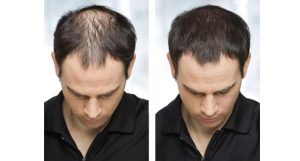Hair loss is a common concern for many men, affecting their self-esteem and overall confidence. With numerous treatment options available, navigating the choices can be overwhelming. This guide explores the most effective methods for treating hair loss in men, providing insights into both medical and non-medical solutions to help you achieve healthier, fuller hair.
1. Understanding Hair Loss
Before diving into treatment options, it’s essential to understand the causes of hair loss in men. The most common type is androgenetic alopecia, also known as male pattern baldness. This condition is largely hereditary and results from the gradual shrinking of hair follicles, leading to thinner hair and eventual baldness. Other factors contributing to hair loss include hormonal imbalances, stress, poor diet, and certain medical conditions.

2. Medical Treatments
Several medical treatments can address hair loss effectively. These treatments vary in their approach, from topical solutions to oral medications and advanced procedures.
- Minoxidil: Minoxidil is an over-the-counter topical treatment that stimulates hair follicles and promotes hair regrowth. Available in liquid or foam formulations, it is applied directly to the scalp. While effective for many users, results can vary, and ongoing use is required to maintain the benefits.
- Finasteride: Finasteride is a prescription oral medication that works by inhibiting the enzyme responsible for converting testosterone into dihydrotestosterone (DHT), a hormone linked to hair loss. By reducing DHT levels, finasteride helps to slow hair loss and promote regrowth. It is usually effective for men with early to moderate hair loss and requires continuous use to maintain results.
- Low-Level Laser Therapy (LLLT): Low-level laser therapy uses laser light to stimulate hair follicles and improve circulation in the scalp. This non-invasive treatment aims to enhance cellular activity and promote hair growth. LLLT is typically used in conjunction with other treatments and can be administered in clinics or through at-home devices.
3. Hair Transplant Surgery
For those seeking a more permanent solution, hair transplant surgery offers a highly effective option. There are two primary types of hair transplant techniques:
- Follicular Unit Transplantation (FUT): In FUT, a strip of scalp is removed from the donor area (usually the back of the head) and divided into individual follicular units. These units are then transplanted to the thinning or balding areas. This method is effective for large areas of hair loss but may leave a linear scar.
- Follicular Unit Extraction (FUE): FUE involves extracting individual hair follicles from the donor area and transplanting them to the recipient site. This technique is less invasive and does not leave a linear scar, but it may require a larger number of grafts to achieve the desired results.
Both methods have proven effective, but the choice depends on individual preferences, the extent of hair loss, and the surgeon’s recommendations.
4. Lifestyle Changes and Home Remedies
In addition to medical treatments, certain lifestyle changes and home remedies can support hair health and potentially reduce hair loss.
- Healthy Diet: A balanced diet rich in vitamins and minerals is essential for maintaining healthy hair. Incorporate foods high in protein, iron, zinc, and vitamins A, C, and D to support hair growth.
- Stress Management: Chronic stress can contribute to hair loss. Practicing stress-reducing techniques such as exercise, meditation, or yoga can help maintain overall well-being and minimize hair loss.
- Scalp Care: Regular scalp massages can improve blood circulation and promote hair growth. Additionally, using mild, sulfate-free shampoos and conditioners can prevent scalp irritation and maintain hair health.
- Natural Remedies: Some men find natural remedies beneficial. For example, essential oils like rosemary and peppermint are believed to stimulate hair follicles and promote growth. However, evidence supporting the effectiveness of these remedies is limited, and they should be used with caution.
5. Emerging Treatments and Research
The field of hair loss treatment is continually evolving, with new research and advancements emerging regularly.
- Platelet-Rich Plasma (PRP) Therapy: PRP therapy involves drawing a small amount of blood from the patient, processing it to concentrate platelets, and injecting it into the scalp. The growth factors in the PRP are thought to stimulate hair follicles and promote regrowth. This treatment is gaining popularity for its potential benefits and minimal side effects.
- Stem Cell Therapy: Stem cell therapy aims to regenerate hair follicles by using stem cells to stimulate new hair growth. Although still in the experimental stages, this innovative approach holds promise for future hair loss treatments.
- Genetic Research: Ongoing genetic research seeks to understand the genetic factors contributing to hair loss better. This research may lead to targeted therapies and more effective treatments in the future.
6. Consulting with a Specialist
Given the variety of treatment options available, consulting with a hair loss specialist is crucial. A specialist can assess your specific condition, recommend appropriate treatments, and provide personalized advice based on your needs and goals. This professional guidance ensures that you choose the most effective approach for your situation.
7. Managing Expectations
It’s important to have realistic expectations when pursuing hair loss treatments. While many treatments can be effective, results vary from person to person, and no solution guarantees complete restoration of lost hair. Patience and persistence are key, as it may take several months to see noticeable improvements.
Conclusion
Treating hair loss in men involves a range of options, from medical treatments and surgical procedures to lifestyle changes and emerging therapies. By understanding the various methods available and consulting with a specialist, you can make informed decisions and develop a personalized plan to address your hair loss concerns. Whether you choose non-invasive treatments, surgical solutions, or a combination of approaches, taking proactive steps can help you achieve healthier, fuller hair and boost your confidence.